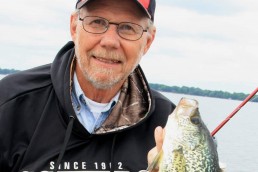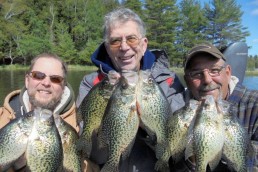SHARE THIS POST
It’s summer, it’s hot, and long-gone are those days of spring when the crappie were spawning and a lot easier to locate and catch. For an angler to be successful at catching big crappies during this hot weather season, changes will without a doubt have to be made in the overall approach. Because right now, my friends, it’s a whole different ballgame compared to earlier in the year. It’s very important to realize that when fishing for crappie during these hot weather months, we must adjust our approach to fishing differently than we did earlier in the season. I find that it is extremely important for fishermen to learn to adapt to the seasonal movements and patterns of the fish that he or she is seeking to catch, crappie being no exception.
Now, long after the spawn is over, and also due to the fact that the waters have warmed to temperatures that are above the crappies comfort zone, they will leave the relatively shallow water locations where we found them earlier in the year in search of more suitable deep water locations of cooler water, where they will tend to gather into large schools. This water can be 20 feet deep or more in some cases, if these depths exist in the particular body of water where they live.
Over years of talking with anglers at my seminars on crappie fishing, I have found that one of the most frustrating problems that anglers seem to face when fishing for crappie during hot weather is that the schools can be very difficult to find, and even when they are located, the school may roam and change its location often. When this happens, you must start your search all over again.
For this kind of fishing, a top quality fish finder unit is an absolute must-have piece of equipment when searching for these roving crappie fish. You will be able to use these electronic tools to not only locate the fish, but to also follow them as they move and change their location. Once a school is located, staying on them is much easier using electronics.
Keep in mind that when you are looking for these schools, it is very common to find crappie suspended anywhere from the bottom up to just below the surface in some cases. This is very important to remember. Even though the crappie are favoring deep water locations as I mentioned, they will suspend at different depths at different times.
Think structure
Lets not forget that crappie are structure-oriented fish, and even though they have moved deep, they will still relate to features such as mid-lake creek channels, sunken islands, deep shoreline drop offs, etc. Deep-water points and flats on river systems that extend out from shore and have depth will also attract and hold crappie during the hot weather periods of the year.
For those of you folks that do not have any type of electronic aids in your boat to assist you in finding the schools of crappie, no problem. Albeit a bit harder, you can still be successful in locating crappies. You folks can slow drift an area with your bait until contact with the crappie is made. Carry some floating markers in your boat and toss one out as soon as you have a hook up. Now, work the area around the marker thoroughly to check for other fish. If the action is slow, do not waste much time there. Pick up the marker and start your drift again and repeat the process with the markers when you get another bite. As I stated earlier, though, a fish locator is really the way to go for this kind of fishing. It will make things easier, eliminate the guesswork and keep you in areas that are most likely to hold fish.
Are you enjoying this post?
You can be among the first to get the latest info on where to go, what to use and how to use it!
What to use
More often than not, I will start out by using a nice lively minnow in the 2-inch range on a small jig in the 1/32- to 1/8-ounce range, depending on the depth of the water being fished, and how deep the fish are located. You will usually be able to tell fairly quickly if the fish are hungry for your offering. When using jigs alone and not tipping them with a minnow, I have found that the best success has come using light colors such as pink, white, yellow or chartreuse, with a small plastic twister tail added. If you find that one color is not producing, don’t hesitate changing to give the fish a different look. Sometimes the slightest change will make the difference. It is important to be open minded and versatile in your approach. If you’re fishing with a partner, each start with a different color bait and each explore different depths.
The speed at which you retrieve your offering will also make a big difference in crappie fishing. Start by going as slow as you can while still maintaining the action of your jig and tail. Try different retrieves until you find the one the fish are looking for.
When it comes to tackle, I advocate for light line and light action rods, even more so for crappie. Not only will you catch more fish with light tackle, but you will find that you enjoy it more. Very seldom do I use line that is heavier than 4-pound test when fishing for crappie. Just make sure you use a good quality line on your reels.
One last deadly crappie presentation that I use, and would like to see more fishermen using, is the simple slip float rig. This rig when used with a plain minnow is extremely effective in catching fish. You can fish deep and maintain constant depth control, which helps you keep your bait at the precise level the fish are holding at.
In winding down this month, I’d like to mention that when crappie fishing, just use a short, firm wrist-snap to set the hook. Crappies have a very soft mouth and the angler that insists on using the old “Cross Their Eyes” hook set method we have all heard about will lose many more fish than he/she catches.
So there you have it my friends—by learning the movements of the crappie during the hot weather season, and adjusting your tactics to match, you can catch these tasty fish during the heat of summer. With that said, get out and give it a try. They’re deep, they’re hungry and they’re waiting for you.
MWO
SHARE THIS POST
Did you enjoy this post?
You can be among the first to get the latest info on where to go, what to use and how to use it!
Mike Cyze
Mike Cyze has been called one of the most knowledgeable multispecies river anglers in the country. His ability to catch fish under the challenging conditions encountered in the river environment, combined with his overall fishing knowledge, has earned him recognition as a true Mississippi River Expert. Contact him at: lastcast13@yahoo.com.



